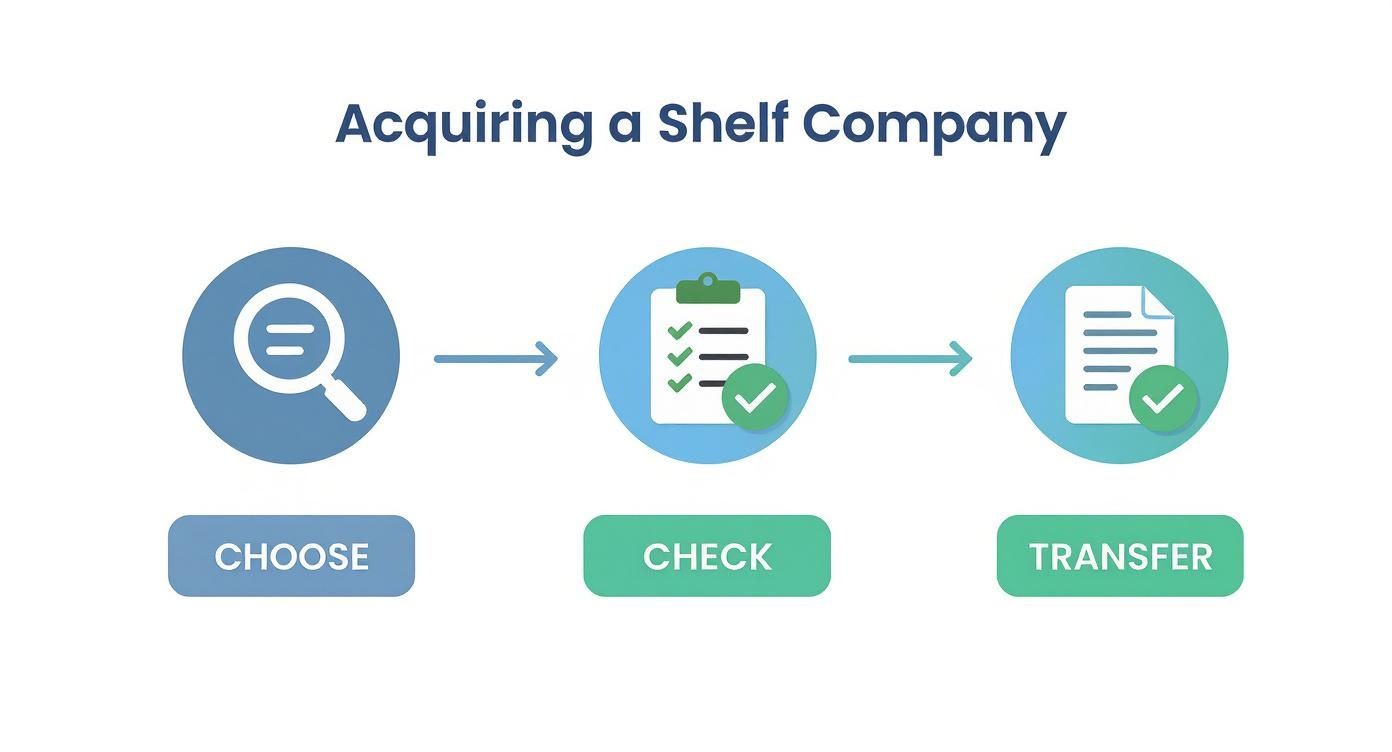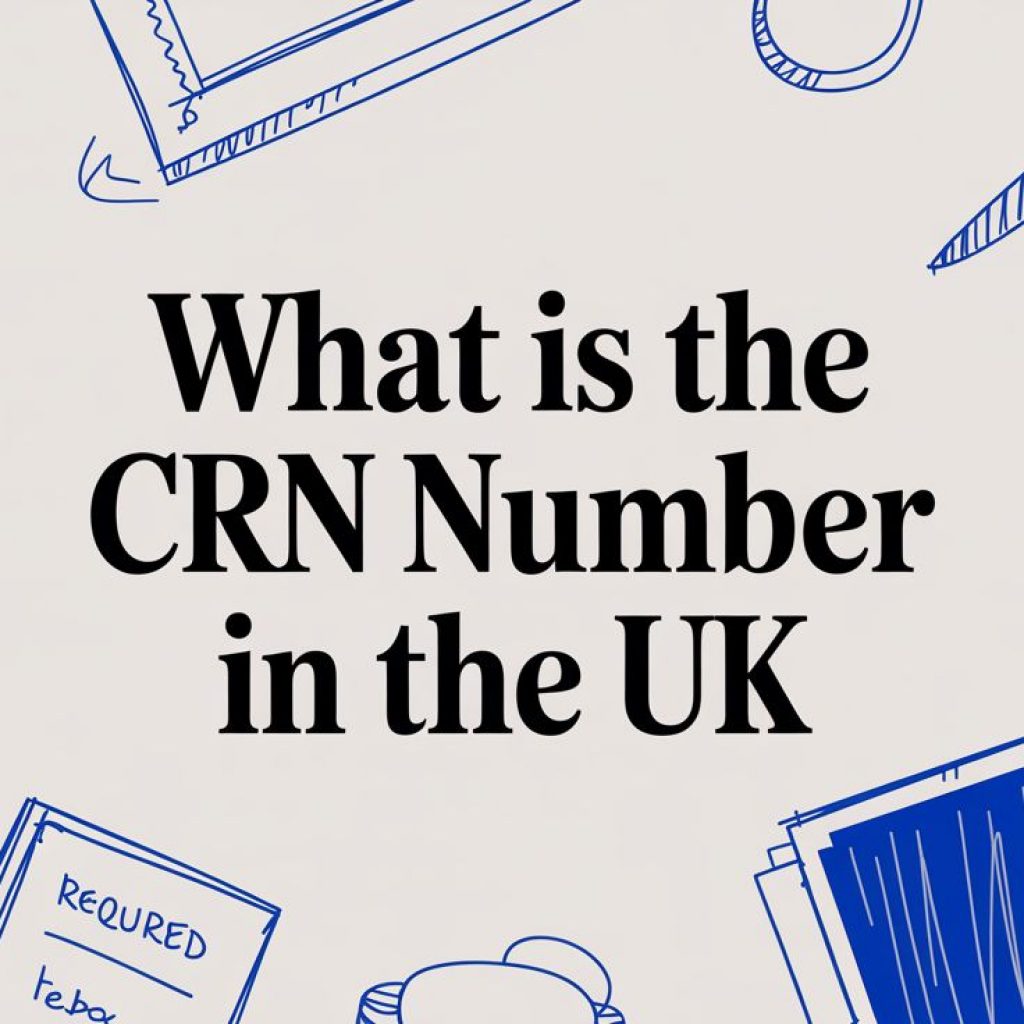Your Guide to a Director Service Address
So, what exactly is a shelf company?
Imagine a brand-new house that’s already built, registered, and ready to go. It has an official ‘build date’ on the records, but it’s been kept completely empty. This allows you to move in and get started straight away. That’s pretty much what a shelf company is—a pre-registered business that’s never traded and exists purely to be sold. Its main value is its established age, which can instantly give your new venture a sense of stability and history.
Understanding The Core Concept of a Shelf Company

At its heart, a shelf company is a legal shortcut. It’s a limited company formed by a provider, given a generic name, and then left dormant—or ‘on the shelf’. This entity has absolutely no trading history, no assets, and no liabilities. It’s a completely clean slate for a new owner.
The whole point is to give an entrepreneur a business that already has an aged incorporation date. Even though modern company registration is faster than ever, there are still plenty of strategic reasons why an older company is more appealing.
Key Characteristics at a Glance
A shelf company isn’t just any company; it’s defined by a few distinct traits that set it apart from a brand-new business. Getting your head around these is crucial before you even think about buying one.
Let’s break down the core traits that define a UK shelf company in this simple table.
| Characteristic | Description |
|---|---|
| Pre-Registered and Dormant | It’s already on the books at Companies House and has been kept in a non-trading, dormant state. |
| No Commercial History | The company has never done any business, taken on debt, or signed any contracts. It’s a blank canvas. |
| Established Incorporation Date | Its main selling point is its age. A company registered three years ago is often seen as more credible than one set up last week. |
| Ready for Immediate Transfer | Ownership can be transferred to you very quickly, letting you take the reins and start trading without delay. |
Essentially, you’re buying the company’s age without inheriting any of its problems.
A shelf company in the UK is a pre-registered limited company that has never traded or conducted any business activity and is kept dormant until purchased. Despite fast electronic company formation, they still account for roughly 15% of new business acquisitions in the UK, remaining a practical option for those needing instant corporate history. You can discover more insights from Companies House data and trends on the official government statistics website.
Once you acquire the company, you’ll need to sort out the paperwork to appoint new directors, potentially change the company name, and update its official business address. You can learn more about this in our guide explaining what is a registered office.
Why an Aged Company Might Be Your Best Move

The number one reason people buy a shelf company is simple, yet incredibly powerful: instant history. In business, trust is everything, and an established incorporation date immediately projects an image of stability and experience. This perceived credibility can be a huge advantage, making your business look far more reliable to potential clients, partners, and even lenders.
Think about it from a customer’s perspective. A company registered yesterday might raise a few eyebrows or face some scepticism. But a company with a three-year history? Even if it’s never actually traded, it inspires a different level of confidence. It suggests you’re not just a fleeting idea but a serious, established entity.
Gaining a Competitive Edge with Corporate Age
This established presence isn’t just for show; it opens real doors to tangible opportunities. Many contracts, especially in sectors like construction or government procurement, have strict minimum business age requirements. A brand-new enterprise would be out of the running before it even started.
Here’s a practical example: a new construction firm wants to bid on a lucrative government tender to refurbish a local school. The catch? All applicants must have been incorporated for at least three years to prove stability. By acquiring a clean three-year-old shelf company, the firm instantly ticks that box and can submit a competitive bid. Without it, they’d be stuck on the sidelines for years, missing out on crucial growth opportunities.
The same logic applies when you’re seeking credit from suppliers or applying for business loans. While any lender will, of course, scrutinise your business plan and financials, an older company registration number can help you get past initial automated screening processes that often filter out new businesses.
In certain industries, an older incorporation date can be the key that unlocks access to high-value contracts or essential lines of credit. It’s a strategic tool for bypassing the ‘new business’ penalty box and positioning your venture for immediate growth.
Other Strategic Motivations for Acquiring a Shelf Company
Beyond building credibility, there are other very specific reasons why buying a shelf company is a smart strategic move. These scenarios often solve unique business challenges that a fresh company formation simply can’t.
Here are a few other key benefits:
- Securing a Desirable Company Name: Sometimes, the perfect name for your business is already registered to a dormant company. Buying that specific shelf company is the most direct—and often only—way to get the name you really want.
- Faster Operational Readiness: The process of acquiring and transferring ownership of a ready-made company can sometimes be quicker than registering a new one from scratch, particularly if Companies House is facing backlogs. This means you can start trading almost immediately.
- Acquiring a VAT Registration: In some specific (and increasingly rare) circumstances, a shelf company might come with a pre-existing VAT registration number. This can be a major benefit for businesses that need to start charging VAT right away, helping them skip potential delays in the VAT application process.
Ultimately, choosing a shelf company is a calculated decision to gain an immediate competitive advantage. By leveraging its age, you can open doors that would otherwise remain firmly shut for a new startup.
Weighing Up the Pros and Cons
Deciding whether a shelf company is right for you means taking a clear-eyed look at both the upsides and the potential pitfalls. It’s a classic balancing act: are the immediate benefits of age and credibility worth the extra cost and the critical need for background checks?
On one hand, the advantages are pretty compelling. An aged company lets you skip the entire formation process and get down to business almost overnight. When a golden opportunity appears and you need to move fast, that speed can make all the difference.
But it’s not just about speed. The real prize for many is the instant corporate image. An older incorporation date suggests stability and experience, which can be a huge help when you’re trying to win contracts, get credit from suppliers, or build trust with clients who might be hesitant to work with a brand-new business.
The Major Benefits of a Shelf Company
For many entrepreneurs, the strategic advantages are what seal the deal. These aren’t just cosmetic perks; they can open doors to real business opportunities that a new venture might struggle to access.
The main rewards include:
- Instant Credibility: An established company history can make your business look more trustworthy and reliable to potential partners, clients, and customers from day one.
- Access to Contracts: Many public and private sector tenders require companies to have been in business for a minimum number of years. A shelf company lets you leapfrog that requirement instantly.
- Better Financing Prospects: While it’s no guarantee, some lenders might look more favourably on an older company during initial credit checks. This could potentially smooth the path to securing loans or getting better terms from suppliers.
The Critical Risks You Can’t Ignore
However, those benefits come with some significant risks that you absolutely must consider. The most obvious downside is the higher upfront cost. Aged companies are sold at a premium, and the older the company, the higher the price. This is a big jump compared to the tiny fee for registering a new company from scratch.
But the far more serious risk is hidden in the company’s past. If it hasn’t been properly vetted, a shelf company could be a ticking time bomb of hidden liabilities.
The single biggest danger of buying a shelf company is inheriting undisclosed debts, unresolved legal disputes, or a terrible credit history. This is why doing your homework isn’t just a good idea—it’s absolutely essential to protect your investment.
Imagine this nightmare scenario: you buy what you think is a clean, three-year-old company to start your e-commerce business. Months later, you receive a letter from a creditor demanding payment for a large order placed by a previous director—completely unknown to you or the seller. This is precisely why working with a reputable provider that guarantees the company’s dormant status is so crucial. You need a warranty that the company is completely free of any financial or legal baggage. Without that assurance, the rewards can quickly be wiped out by expensive and damaging problems.
Your Step-by-Step Guide to Acquiring a Shelf Company
So, you’ve decided a shelf company is the right move for your business. The next step is navigating the purchase, which can feel a bit daunting if you’ve never done it before. Don’t worry, it’s a straightforward process when you know what to expect.
We’ll walk you through every administrative and legal step, ensuring you stay on the right side of UK regulations. It really boils down to four key stages:
- Select a Reputable Agent
- Choose Company by Age and Name
- Perform Due Diligence
- Transfer Ownership and Update Records
Let’s break these down.
Choose a Trustworthy Formation Agent
Your first decision is probably the most important one: picking the right provider. A good agent makes the entire process smooth and transparent, while a bad one can lead to headaches down the line. Look for a company with a solid track record in UK formations and clear, upfront pricing.
Before you commit, it’s worth checking a few things:
- What’s their reputation like in the industry? Search for online reviews and testimonials.
- Are their fees easy to understand, with no hidden extras?
- Do they provide a warranty or certificate confirming the company has never traded?
- Will they offer support after the purchase to help with the necessary updates at Companies House?
Evaluate Available Companies
Once you’ve found an agent you trust, they’ll show you a list of available shelf companies. This is where you match a company to your specific needs. For instance, if you’re a construction firm bidding on a contract that requires three years of history, you’ll need a company that’s at least that old.
As you browse the options, keep these points in mind:
- Compare company ages to ensure they meet any tender or credibility requirements you have.
- Confirm the company has genuinely never traded. It should have been kept dormant.
- Verify the name is generic enough to fit your branding, or check if it can be easily changed post-purchase.
Visual Process Flow
To make it even clearer, here’s an infographic that lays out the major steps in buying a shelf company, from picking your agent right through to completing the transfer.

This flowchart gives you a bird’s-eye view of how to choose, check, and transfer your new company efficiently.
“A step-by-step process ensures you avoid hidden liabilities and stay compliant with Companies House requirements.”
Now we’re at a critical point in the process: the checks you must carry out before signing on the dotted line.
Perform Thorough Due Diligence
This is your safety net. Proper due diligence protects you from inheriting any nasty surprises like hidden debts or legal issues. Your agent should provide a guarantee, but it’s vital you confirm the company is in good standing with Companies House. A Certificate of Good Standing is solid proof.
Make sure you:
- Verify there are no outstanding debts or tax filings. A credit check on the company registration number is a wise step.
- Check the company’s public record on the Companies House website for any red flags.
- Review the dormant accounts to get absolute confirmation of zero trading activity.
Complete Ownership Transfer
Once your checks are complete and you’re happy, it’s time to make it officially yours. This involves transferring the shares and appointing your new directors.
The final steps usually look like this:
- Sign a share transfer agreement (stock transfer form).
- File an update on the ‘Persons with Significant Control’ (PSC) with Companies House.
- Update the registered office address and SIC code (the code that describes your business activity).
- Appoint the new directors by submitting Form AP01 for each one.
Don’t forget to update the director service addresses as well, so they reflect the new appointments.
For more on keeping your company compliant while it’s not trading, you might find our article on dormant company management useful.
With all these steps ticked off, your shelf company is fully updated, legally yours, and ready for business.
Post-Acquisition Checklist
Getting the company is just the beginning. To avoid penalties and keep everything running smoothly, you need to stay on top of your ongoing compliance duties.
- File your annual confirmation statement within 14 days of the company’s anniversary date.
- Submit accounts to Companies House on schedule, whether they are dormant or full trading accounts.
- Update the PSC register immediately if there are any changes in ownership.
- Notify HMRC of any changes to your business activity or registered address.
Actionable Insight: Set up digital calendar reminders for key dates like the confirmation statement due date and the accounting reference date. A good formation agent can also provide a compliance checklist to help you stay organised and proactive.
How To Perform Due Diligence and Stay Compliant

Buying a shelf company isn’t just a simple transaction; it’s an exercise in trust and thorough verification. This is the single most critical stage of the whole process, where doing your homework protects you from inheriting a whole host of hidden problems.
Proper due diligence is your guarantee that the company is a genuinely clean slate, not a liability waiting to spring a nasty surprise on you down the line.
The main goal here is to confirm, without a shadow of a doubt, that the company has a spotless record. That means verifying it has never traded, holds no debts, and has a clean credit file. A reputable provider will guarantee this, but you should still understand what to look for so you can make a properly informed decision.
Your Essential Due Diligence Checklist
Before you finalise anything, you or your provider must meticulously work through a checklist. This isn’t just a box-ticking exercise—it’s your financial safety net. Skipping these steps is a risk you simply can’t afford to take.
Here are the key checks to make:
- Confirm Zero Trading Activity: You must request and review the company’s dormant accounts that have been filed with Companies House. This is the official, concrete proof that no business has ever been conducted.
- Verify No Debts or Liabilities: Get written confirmation that there are no outstanding loans, unpaid invoices, or looming legal claims against the company. A clean credit file isn’t just a ‘nice to have’; it’s non-negotiable.
- Check for a Certificate of Good Standing: This is an official document from Companies House confirming the company is fully up-to-date with all its statutory filings and has a compliant history.
A Certificate of Good Standing is your strongest assurance that the shelf company has been properly maintained and meets all regulatory requirements. Always request this from the seller as a condition of the purchase.
Staying Compliant After the Purchase
Once the company is officially yours, the responsibility for keeping it compliant shifts squarely onto your shoulders. Ownership comes with ongoing legal duties that you must meet to keep the company in good standing with UK authorities like Companies House and HMRC.
As the new owner, you’ll need to handle filing an annual confirmation statement, submitting yearly accounts, and meeting all tax obligations. It’s also vital that all new directors meet their legal duties, which now includes identity verification.
Actionable Insight: Create a simple compliance calendar for your new company. Mark the deadlines for your annual accounts and confirmation statement. This small organizational step can save you from late filing penalties and unnecessary stress.
By combining rigorous checks upfront with diligent management afterwards, you can avoid costly mistakes and legal headaches, letting you focus on what really matters: growing your business with confidence.
So, Is a Shelf Company Actually Right for Your Business?
Choosing between a shelf company and forming a brand new one boils down to one thing: your immediate business goals. This isn’t just an administrative tick-box exercise; it’s a strategic decision. You need to weigh up the need for instant history against the higher cost and the homework you’ll have to do.
To get to the right answer, ask yourself a few direct questions. Is building credibility with investors or suppliers your absolute top priority right now? Do you need to look established from day one to win a specific contract that has a minimum business age? If the answer is a resounding “yes,” then an aged company could be a seriously powerful tool.
On the other hand, are you ready for the higher upfront cost? And are you prepared to do the rigorous checks needed to make sure the company is completely clean? If your budget is tight or you simply don’t need that instant corporate history, a standard formation is almost always the more practical and sensible choice.
Looking at it in the Real World
Let’s paint a picture with two different scenarios to make this choice clearer.
- Scenario A: The International Consultant. An experienced IT consultant from overseas wants to win a major UK project. The problem? The tender document states all applicants must have been incorporated in the UK for at least two years. By buying a clean, two-year-old shelf company, she instantly meets the criteria and can compete for a high-value contract that would otherwise be inaccessible. For her, the investment is a clear strategic advantage.
- Scenario B: The Local Artisan. A talented local artist is launching an e-commerce store to sell handmade crafts. His main needs are a simple legal structure and a way to take online payments. His credibility will come from glowing customer reviews and the quality of his work, not the date on his incorporation certificate. A standard, low-cost company formation is the logical and far more cost-effective path for him.
The decision really hinges on one question: does the strategic value of an established incorporation date outweigh the extra expense and legwork? Let your business ambitions be your guide.
By weighing these factors, you can confidently pick the path that aligns perfectly with your goals and sets your venture up for success right from the start.
Got Questions? We’ve Got Answers
If you’re wondering what a shelf company is and how it all works here in the UK, you’re not alone. We get asked these questions all the time. Let’s tackle four of the most common queries to help you figure out if it’s the right move for you.
How Much Does a UK Shelf Company Cost?
The price tag on a shelf company really depends on its age and who you buy it from. Think of it like a fine wine – the older it is, the more valuable it becomes.
A relatively young company, say two years old, might set you back between £400 and £600. If you’re looking for something with a bit more history, a five-year-old company could cost anywhere from £700 to £1,200.
- Age Matters: Older companies simply command higher fees due to their established history.
- What’s Included?: The basic package always includes the registration number, incorporation date, and all the standard documents.
- Optional Extras: Need to change the company name or update the registered office? These services will usually come with a small additional charge.
Can I Change the Company Name?
Absolutely. Once you’ve bought the shelf company, you’re free to rename it to match your brand. It’s a straightforward process.
Here’s what’s involved:
- First, you’ll need to file a special resolution with Companies House.
- There’s a small official fee to pay, which is currently just £8 if you do it online.
- Finally, don’t forget to update your own records, like your statutory registers and company letterheads.
Once Companies House gives it the green light, the name change is usually complete within 24–48 hours.
Is Buying a Shelf Company Legal?
Yes, buying a shelf company in the UK is 100% legal and above board. It’s a well-regulated process, so you’re simply acquiring an existing business entity without breaking any rules.
- The whole process is governed by the Companies Act 2006.
- Companies House oversees everything, ensuring complete transparency.
- Just remember, you have a legal duty to register any changes to the Persons with Significant Control (PSC) right away.
Does It Come With a Bank Account?
This is a common misconception. Shelf companies don’t come with an active bank account. That’s something you’ll need to set up yourself after the purchase.
You’ll have to:
- Pick a bank and go through their standard application process.
- Provide all the necessary documents, like proof of ID, address, and the company’s papers.
- Once approved, you can link the new account to your company records.
What Else Do I Need to Do?
After you get the keys to your new company, there are a couple of housekeeping tasks you need to sort out within 14 days. You’ll need to update the registered office address and the PSC register.
You might also want to:
- File your first confirmation statement to keep your details current.
- Decide whether to file dormant or trading accounts, depending on your plans.
- Set up a professional email and domain name to start building your brand’s presence.
Staying on top of these small tasks is key to keeping everything compliant.
Ready to find the perfect shelf company for your venture? Partner with Acorn Business Solutions and let’s get you started today: https://acornbusinesssolutions.com






